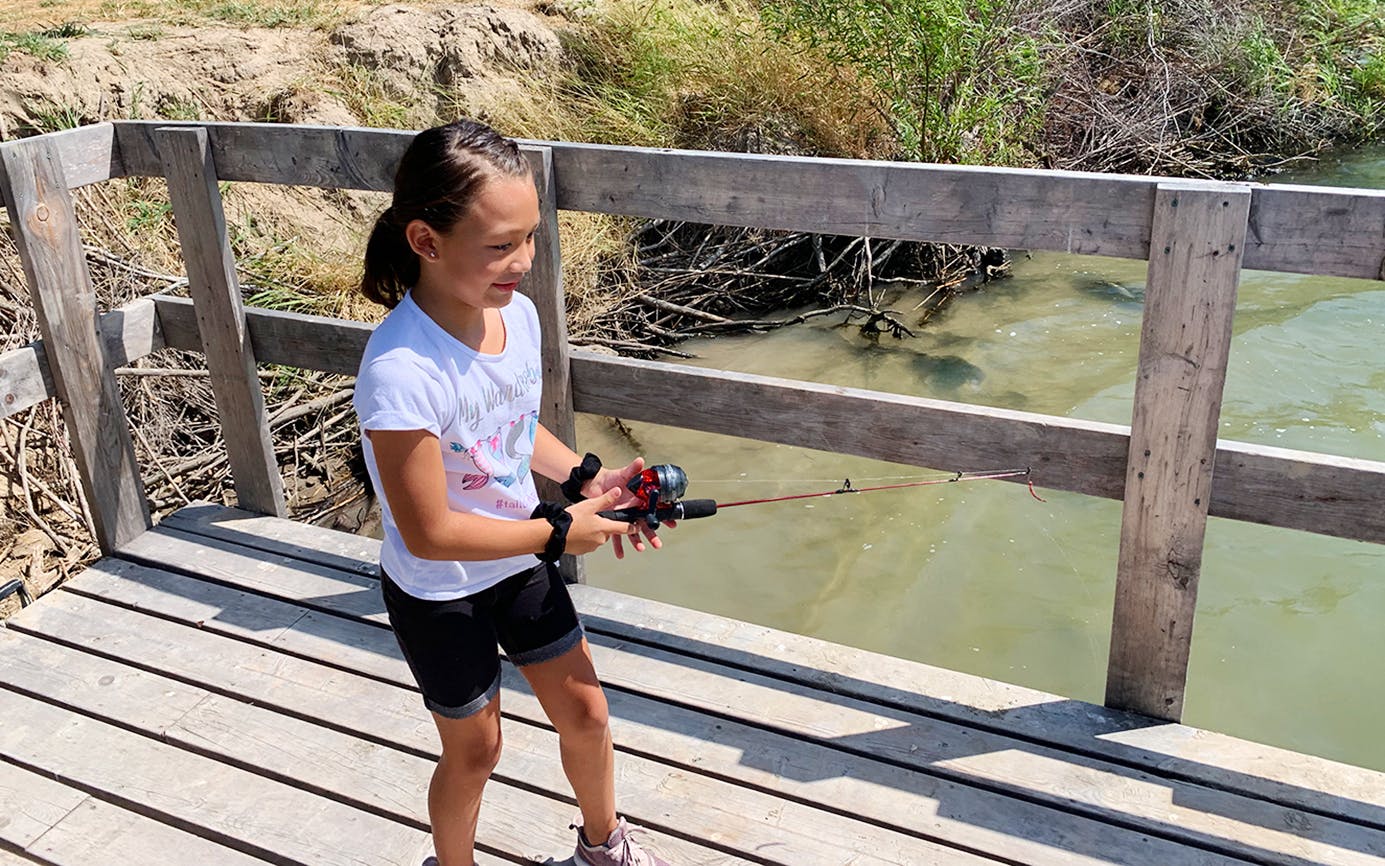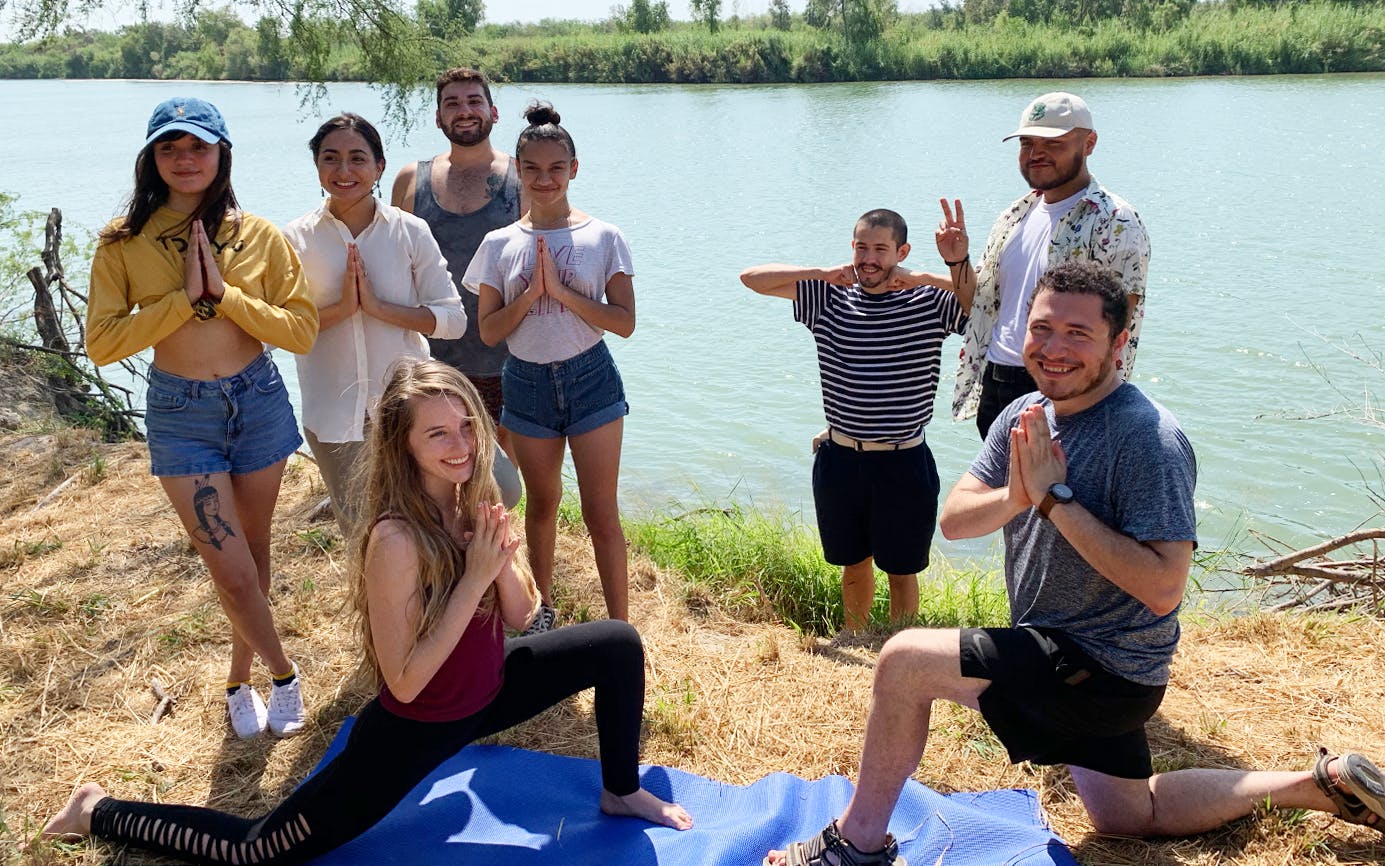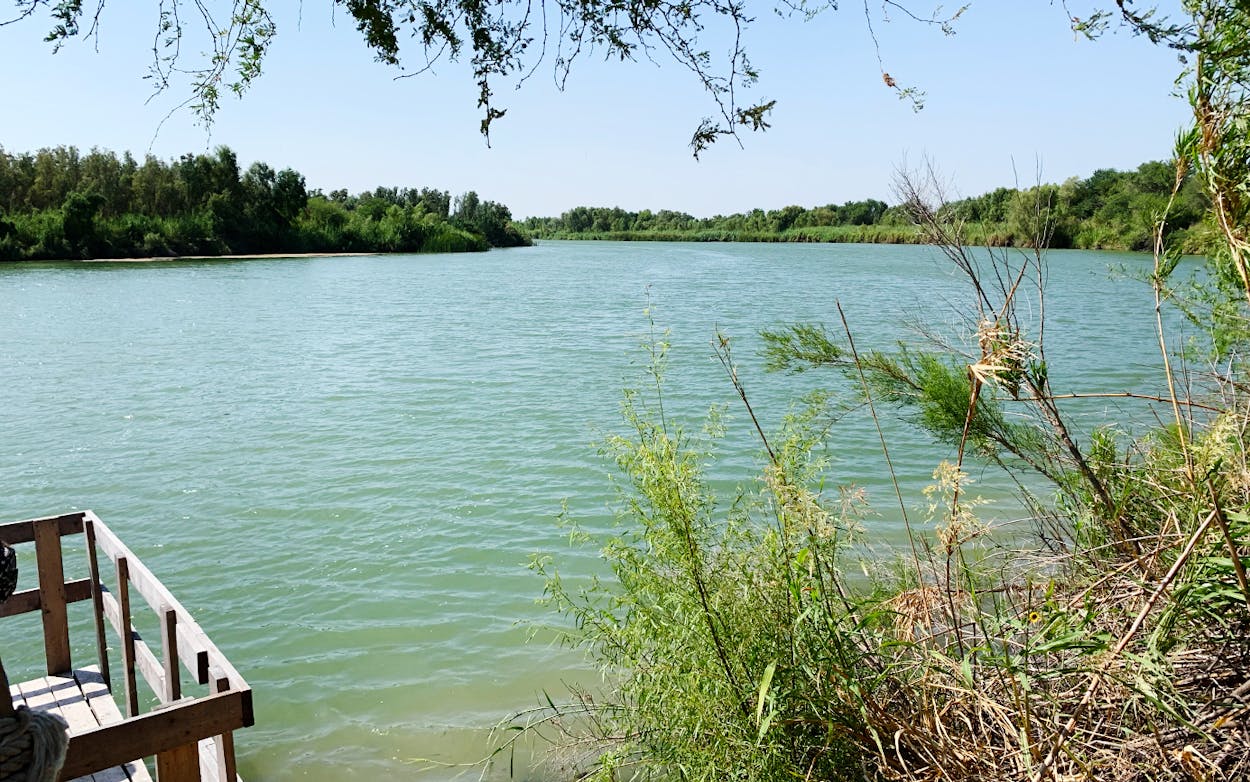A surprisingly fresh breeze blew off the river as I watched six-year-old Enrique Vargas cast a fishing line. Within seconds, he pulled it from the cool water, declaring that he’d felt a tug. When the hook emerged sans bait, Enrique expressed frustration. “The fish keep eating my fish,” he told me. His mother, Jasmine Hernandez of the tiny town of La Joya in deep South Texas, stood a few feet away on a floating 10-by-10-foot dock. She knew that her son, despite the lost bait, was creating lifelong memories as he and his stepsister, Jaylynn, enjoyed nature along the Rio Grande.
Just a few miles away, in a well-fortified enclosure beside well-traveled Conway Road in Mission, are acres of stacked, rusty-looking steel bollards—the building material for President Trump’s border wall. The federal government marches forward in its efforts to fulfill his campaign promise and add nearly one hundred miles of a border barrier across three of Texas’s southernmost counties: Starr, Hidalgo, and Cameron. While local activists remain committed to preventing new wall construction, a fatalism is creeping into the spirit of the people of this region. Many reflect on what might soon be lost: access to the Rio Grande itself, a once mighty and still swift-flowing river that first attracted the area’s settlement centuries ago.
“The Rio Grande river is our lifeblood in every way,” said Marianna Treviño Wright, executive director of the National Butterfly Center, which occupies one of the most sensitive areas threatened by what many consider Trump’s scorched-earth border security policy. “It doesn’t so much divide two countries. For those of us who live here and grew up here, it simply separates two communities that have always been bound together.”

Two years ago, U.S. Customs and Border Protection appeared likely to destroy one of the region’s most beloved edifices: the 120-year-old La Lomita Mission, the namesake of the city of Mission. The adobe chapel sat in a 150-foot “enforcement zone” just beyond the proposed route of the border wall that was slated to be clear-cut. La Lomita’s pastor, Father Roy Snipes, known variously as Father Roy or the “cowboy priest,” led a march from Our Lady of Guadalupe Catholic Church to La Lomita, a distance of just over four miles. More than one thousand people joined the protest.
A year later, with the proposed wall construction also threatening the butterfly center and neighboring Bentsen-Rio Grande Valley State Park, Wright decided to commemorate Roy’s march by hosting an event she called “Reclaim the River,” a day for families to gather and enjoy the grounds of the butterfly center and the Rio Grande, which borders the preserve. More than four hundred people showed up.
Though Congress passed some protections against building through Bentsen or the butterfly center early this year, Wright again hosted a Reclaim the River event last weekend. This time, perhaps because of mistaken perceptions that the butterfly center is now entirely safe from the wall, no more than one hundred people participated.
I was one of them, along with my wife and teenage daughter. The butterfly center is a one-hundred-acre habitat situated at a migratory crossroads between the United States and Mexico—an important waypoint on the annual journey of monarch butterflies. Years ago, I fell in love with the legend of the monarch, which passes through this region around the time of Mexico’s fabled Day of the Dead celebrations, which begin on Halloween and last through November 2. For generations, I learned, many people of the region believed the monarchs to be the souls of departed family members.

Now presidential politics and the wall threaten the South Texas lore of the monarchs. Two-thirds of the butterfly center sits between the Rio Grande and a federally owned earthen levee, which aids in flood control. Since the border wall cannot be built in the floodplain beyond the levee, most of the butterfly center’s property would be consigned to a no-man’s-land if the wall were built.
Unhappy with congressional funding for the barrier, Trump in February declared a state of emergency, claiming the power to draw billions of dollars more from the Department of Defense for wall construction. The Supreme Court last month ruled to allow the administration to continue using military funding for the wall while litigation over his circumvention of Congress continues. It has not been determined whether Trump’s declaration allows him to build in areas, like the National Butterfly Center, where construction had been expressly prohibited by the congressional appropriation.
Wright and other activists are left with the disquieting sense that nothing in the region is truly protected. An eighteen-foot concrete base, another eighteen feet of steel bollards on top of that, and a 150-foot enforcement zone denuded of all structures or plant life could yet cut off significant access to the Rio Grande.
We pulled away from the floating dock in a small boat with an outboard motor, deliberately going slowly to accommodate a woman from Russia and her three children sitting near the bow. Albert Solis was driving. He was raised in Mission and has fond childhood memories of family outings near or on the Rio Grande. Earlier, Wright had told me she learned to water ski on the Rio Grande, and she recalled how the river—about three hundred yards wide and twenty feet deep where we were—was once often teeming with people.
I grew up near the Rio Grande in El Paso, hundreds of miles away, and feel my own kinship with this waterway that I’ve crossed countless times. Because of a long-ago dispute between the United States and Mexico, the river through El Paso is more of a trickle, controlled by a man-made channel to prevent it from naturally shifting and thus creating international tensions over land gained or ceded because of the flow of water. So, as the boat pulled away, I was excited to be actually on the Rio Grande for the first time in my life. This stretch lived up to the river’s name. To my right was the United States; to the left, Mexico. The boat was chugging upstream, against a strong current pushing the craft toward the Gulf of Mexico. I found it hard to fathom families trying to cross this treacherous river to seek economic or political sanctuary in our country.
Tall carrizo cane grows along both banks. It’s technically an invasive species, since it was brought to the New World as a building material more than four hundred years ago and found the Rio Grande especially hospitable. An estimated 100,000 acres of riverfront have been overrun by it, and eradication programs exist on both sides of the river. Yet, from the boat, the green canopy it created was beautiful. Because others were waiting their turns for a boat ride, we only traveled a few hundred yards before turning back.
The absence of virtually any man-made structure, just miles from an urban core, reminded me of areas along the Brazos River near Waco, where I learned to kayak years ago. The splashes of water and the cool breeze that made a 90-degree South Texas day bearable reminded me of Lady Bird Lake in Austin, where I perfected my paddling skills. If anyone were to propose that either Austin or Waco allow a 36-foot barrier to cut their cities off from their defining waterways, there would surely be rioting in the streets. So why was this even a possibility for such a magnificent section of the Rio Grande?
Back along the bank, about five feet above the river, Molly Wallace and about a dozen others finished a yoga session as part of the Reclaim the River event. Wallace was born in the Rio Grande Valley and left for Florida for a few years before returning with a newfound appreciation for the natural, rugged beauty of this region. “I love the butterfly center, and I love the Valley. I think it’s really an underrated place that has a totally bad reputation that is not representative of what it actually is,” she told me. “I think events like this are important to show people that this is not the war zone that it’s made out to be.”

As I leave the river and walk to our car, I run into six-year-old Enrique Vargas again. He’s now looking through a microscope set up to show visitors the microorganisms this area supports. I’m reminded of something that Wright had described to me earlier, a generation of people who regularly played on the Rio Grande. It’s a practice, she said, that has slowly died away as the increased presence of law enforcement has spurred stories of danger lurking in these waters—imagined threats overtaking the river’s banks like so much carrizo cane.
Last week, CPB announced that it had completed construction of about fourteen miles of new border wall in the San Diego area. Since Trump became president, the CBP noted, 57 miles of new wall have been built across the country. By the end of next year, the agency is predicting it will have finished building 450 miles of new border wall under the current administration’s watch.
“The construction of the new border wall system supports USBP’s ability to impede and deny illegal border crossings and the drug and human smuggling activities of transnational criminal organizations while increasing safety by allowing agents to observe activity just immediately south of the border wall,” acting San Diego sector chief Kathleen Scudder said in a written statement accompanying last week’s news release.
It could also portend that the generation of Enrique Vargas will be the last in the Valley left free to enjoy the natural splendor of the Rio Grande.
- More About:
- Border Wall
- Donald Trump
- Mission






